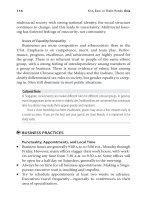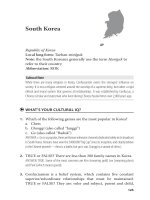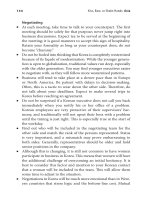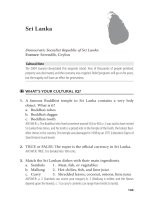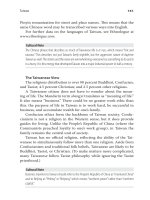How to Understand Business Finance, Second Edition_9 ppt
Bạn đang xem bản rút gọn của tài liệu. Xem và tải ngay bản đầy đủ của tài liệu tại đây (188.82 KB, 18 trang )
134 How to Understand Business Finance
Raw materials
Raw materials are goods that have been delivered to our
company’s warehouse but have not yet been taken into the
production area for conversion. As these are part of working
capital, it would seem that minimising raw material stock is ideal.
However, this must be off set by the economic order quantities
available from suppliers.
Another approach is just in time (JIT) deliveries of raw
materials. In this way, goods can be delivered directly to the
production area, eliminating any raw material store. The aim is
to get our supplier to carry the stock rather than doing this
ourselves.
Work in progress (WIP)
WIP involves any product once it has left the raw material store
until it is declared available for sale and delivery to customers. In
a multi-step process this can also involve intermediate products
awaiting conversion to the next stage. To reduce working capital
we must consider reducing these buff er stocks, eliminating or
combining stages in the production process, reducing the overall
production cycle time, and minimising raw material and fi nished
goods stocks in the production area.
The amount of WIP can also be badly aff ected when diff erent
stages of the manufacturing process takes place on diff erent sites.
This is common when companies acquire an ‘upstream’ or
‘downstream’ processor. In these cases the stock travelling
between sites must also be taken into account.
Finally, we must examine how long it takes for products to be
cleared for sale by our quality control (QC) procedures. Some
organisations have huge stocks sitting in a pending bay awaiting
clearance from QC.
135 Where is all our Cash? Managing Working Capital
Finished goods
‘Finished goods’ refers to the stock sitting in the warehouse awaiting
sale and delivery to our customers. Some of this may have been in
the warehouse for a long time, and if the goods have a shelf-life they
may be unsaleable. In these circumstances we must consult our
technical staff to fi nd out what options we have to dispose of slow-
moving items. Should we repack or reprocess the stock, sell it at a
discount or dispose of it altogether? Good sales and operations
planning can reduce or eliminate the need for fi nished goods stocks.
Examples of best practice in stock management are the car
manufacturers. They use JIT to have components delivered
directly to their production lines at the exact point where the
component is fi tted to the car. Then they ask their suppliers not to
invoice them until a short time later when the fi nished car rolls
off the end of the production line. In this way they minimise or
eliminate both raw material stock and work in progress, as all
their stock is now in fi nished goods.
Debtors
‘Debtors’ refers to the amount of money owed to us by our
customers. This is directly related to how long customers take to
pay their bills. The longer we give them to pay, the more we will
have owed to us at any one time. Inevitably customers are late in
paying their bills. Timely monitoring and enforcement of the
terms under which you do business can help you manage your
debtors better. Other factors can include invoice accuracy, correct
addressing of invoicing to the appropriate department/location at
your customer, off ering a prompt payment discount (a small
percentage discount can have a disproportionate eff ect on
payment times), and establishing maximum credit limits after
which further orders cannot be accepted.
Improvements can be brought about by more regular invoicing
of your customers. Imagine if you only invoice once a month. The
136 How to Understand Business Finance
value of a whole month’s worth of deliveries could be building up
before you even invoice the customer. With today’s electronic
payment systems it is often possible to increase invoicing
frequency with no additional workload after the initial set-up.
In all these areas the key is communicating the issues to your
customers and negotiating better terms rather than simply
imposing them.
How long does it take you to invoice
your customers?
A private hospital with a turnover of £36 million per year was
taking 15 days to collect all the information on what services
and drugs patients had used in the various departments
before sending out bills. With sales of £100,000 per day this
was equivalent to £1.5 million that they had not yet invoiced.
Halving this delay in issuing their bills would release
£750,000 of cash, which could then be used to pay off
loans, buy new equipment etc – a sum defi nitely worth
working towards.
Creditors
Creditors provide a mechanism for funding your business. The
more credit we can get from our suppliers (ie the longer we take to
pay our bills), the better our cash fl ow position. Once again the key
to success is to negotiate better terms and then not pay these bills
until the day they are due.
Asking your suppliers to invoice you monthly or quarterly
rather than every time they deliver can improve your working
capital. This is because the amount outstanding builds up before
you are billed, and therefore you end up with more credit from
your supplier.
137 Where is all our Cash? Managing Working Capital
It is possible to have negative working capital when you can
get more credit from your suppliers than you give your customers.
Consider a trading company that buys from an overseas supplier
with three-month terms (ie 90 days to pay the supplier’s bill) and
sells to its customers on 30 days. This business can receive the
cash on two out of the three months’ worth of bought-in stock
before having to pay its supplier anything.
Supermarkets also work on this basis, eff ectively selling to
consumers for cash and paying suppliers after 30–60 days. This is
why many retailers have started off ering fi nancial services. They
generate a lot of cash, which they can then use before having to
pay their suppliers.
Why payment terms matter
Getting extended credit terms from suppliers is worth more
than any non-fi nancially aware business person ever
imagines – purchasers take note.
Giving extended credit to customers is more expensive
than any non-fi nancially aware business person ever
imagines – salespeople take note.
Write-off s
In all the above examples, where items are carried in the books
which will never realistically be realised (ie turned into cash) then
we must consider writing down their book value, or writing them
off completely.
If we consider reducing the value of something on the top half
of the balance sheet, then we must reduce the value of the bottom
half of the balance sheet, otherwise the books will no longer
balance. This is done by showing a loss for the same amount as the
value we are writing off . In other words, it becomes a write-off cost,
138 How to Understand Business Finance
which reduces the number carried across from the P&L account
into the bottom half of the balance sheet as retained earnings.
Similarly, revaluing an asset by increasing its book value will
result in a paper profi t to balance the bottom half of the books.
This will appear as an additional line in the P&L account.
Both these items can sometimes appear in the accounts under
various terms (eg stock adjustments) and can be found at any level
between the top and bottom line of the P&L account.
Cash fl ow implications of
working capital
As we have already seen, when considering the cash tied up in a
business, there are two main areas: fi xed assets and working
capital. Because we cannot do much to aff ect the day-to-day value
of our fi xed assets, managers concentrate all their eff orts on
managing working capital! Table 13.1 gives a summary of impact of
each element of working capital.
Table 13.1 Impact of diff erent elements of working capital
Item of working capital Cash implications
Stock (inventories) Decrease in stocks releases cash
Increase in stocks consumes cash
Debtors (receivables)
– money owed by customers
Decrease in total value of debtors
releases cash
Increase in total value of debtors
consumes cash
Creditors (payables)
– credit from suppliers
Increase in total value of creditors
releases cash
Decrease in total value of
creditors reduces cash available
139 Where is all our Cash? Managing Working Capital
Generally, managing working capital means reducing working
capital to release cash. This means reducing stocks, and money
owed by customers, and increasing the credit from suppliers.
Working capital will also change as our volume of business
changes. Suppose we are a company with monthly sales of
£100,000 and it takes two months to get our bills paid. This means
at any time we will have two months’ worth of sales, or £200,000,
owed to us. Now we are really successful and grow our sales to
£150,000 per month. How much will we now have owed to us –
£300,000! Where does the money come from, then, to fund this
£100,000 increase in working capital? Well, it must come from
somewhere. Perhaps there is enough cash in the business, or
perhaps we can get another loan. This is one of the reasons that
companies get into cash fl ow diffi culties when they expand too fast.
Lastly, consider what happens when closing down a business,
perhaps because cash fl ow problems just got too much. Inevitably
there will be monies owed from customers yet to be paid. In the
months following the winding up of that company, cash will start
fl owing in as these invoices get paid. It is at times like these that
you might start to regret closing the business: you are cash rich for
the fi rst time in your life! It is an irony of business that cash fl ow
can be at its best when you are selling the least…
140
THIS PAGE IS INTENTIONALLY LEFT BLANK
Glossary of fi nancial terms
absorption costing Full costing. Calculated by dividing the
total fi xed costs incurred during a period by the units sold. The
allocated fi xed cost is added to the variable cost to give the full
cost of the product.
accounting The process of measuring and summarising
fi nancial information about the activities of a business to provide
information to shareholders, managers and employees about what
is happening in the business. See management accounting,
fi nancial accounting.
accounting conventions Principles used by accountants when
preparing accounts so that there is a degree of comparability between
the accounts of diff erent companies, and between accounts for the
same company in diff erent periods. If any changes are made in the
way that accounting conventions have been applied, these must be
disclosed by the auditors in the notes to the annual accounts.
accounts (UK) Financial Statements (US) Books. The records
kept by a business of its fi nancial activities.
141
142 How to Understand Business Finance
accounts payable (US) Creditors (UK). Money owing to
suppliers for goods and services purchased but not yet paid for.
accounts receivable (US) Debtors (UK). Money owing from
customers for goods or services supplied and invoiced, but not yet
paid for. See also DSO.
accrual accounting This recognises the occurrence of income
and expense irrespective of whether cash has moved in or out of
the company at the time the transaction occurs. For example,
when a piece of equipment is bought, the expense will be
recorded, even though payment for it may only be made several
months later. If accrual accounting is not used, the system is
called ‘receipts and payments’ or ‘cash accounting’.
accumulated depreciation This shows the amount of
depreciation suff ered to date. When subtracted from the cost of
the assets, the result is the net book value.
acid test (US) See quick ratio (UK).
activity ratio Asset turnover, spin. Sales revenues divided by
net (or total) assets. This shows the effi ciency with which the
assets used by the business are being used to generate sales,
regardless of the source of the capital. Retailing and service
industries typically have high activity ratios. Manufacturing
industries are typically capital-intensive, with high fi xed and
current asset fi gures, and low activity ratios.
allocation of costs Giving the costs to the product or division
that ‘owns’ them, eg accounting the cost of an advertising
campaign against income from the product advertised.
amortisation Periodically recorded expen ses which show the
gradual reduction of value of an asset or an obligation. Usually
refers to goodwill, patents and other intangible assets, or issuing
expenses of debt securities.
143 Glossary of Financial Terms
assets The things owned by the business. These may include
fi xed assets, current assets and intangible assets.
asset turnover ATO; see activity ratio.
auditing The process of checking the books and accounting
systems of a company to verify that the company’s accounts give a
true and fair view of its fi nancial situation.
auditors’ report A limited company must by law produce a set of
accounts every year, and the auditors must report on whether the
accounts provide a true and fair statement of the company’s
business. The auditors have to investigate the accounts to establish
this, and if they are not satisfi ed with them they produce a ‘qualifi ed
report’ in which they say what they consider to be wrong or
uncertain in the accounts. A qualifi ed report from the auditors can
be damaging to the public image of a company and its share price.
authorised capital The amount of share capital that the
company has been authorised to issue. Stamp duty is paid at the
time of authorisation, and if the directors wish to issue further
shares once the authorised capital is fully issued, they must get
approval from the shareholders. Once authorised, shares may be
issued at the discretion of the company’s board of directors.
bad debts Accounts receivable (US) or debtors (UK) that will
never be collected. ‘Writing off ’ a bad debt means reducing the
debtors fi gure by the amount written off , and putting that in the
P&L account as an expense against profi ts.
balance sheet A snapshot of the fi nancial position of the
business at a given time. It summarises all the assets owned by the
business, the equity invested, and all the liabilities; in lay terms,
what the business has, and where it came from.
bonds Debentures. A way of borrowing.
144 How to Understand Business Finance
book value Net book value. The diff erence between the
purchase cost of an asset and its accumulated depreciation.
break-even point The volume of sales at which total sales equals
total costs, and the company makes neither profi t nor loss. At this
point the contribution exactly equals the fi xed costs. Break-even
volume (in unit sales) is calculated by dividing total fi xed costs by
the unit contribution. Break-even sales turnover is calculated by
multiplying the break-even volume by the unit selling price.
budget (UK) Business plan (US), a man agement plan for
fi nancial achievement over a specifi ed period. This needs to be
supported by an action plan that will give rise to the required
fi nancial results. The budget provides a way of coordinating the
activities of diff erent departments within a company, and for
testing the viability of planned activities. The amount of
commitment shown by employees to a budget is proportional to
their involvement in creating the budget, and the amount of
personal benefi t they expect to receive from achieving it.
budgetary control This is a process of setting budgets, measuring
actual results, and comparing the actual against the budget to see
where variances occur, and what new plans must be made.
burden (US) Overhead costs, indirect expenses. See also overheads.
capital Used in several diff erent senses (eg savings, cash
reserves, equity in a business), it usually means money. Capital
investment means the purchase of long-term assets such as
machines, as opposed to goods for resale, services etc.
capital employed The money used to fi nance a business.
Calculated as share capital plus reserves (qv), plus long-term
loans; or as total assets less current liabilities.
capital expenditure The purchase of fi xed assets.
145 Glossary of Financial Terms
capital surplus Money received from the sale of shares, over
and above their face value. For example, if 100 new £1 shares are
sold at the current market value of £5 each, £100 will be added to
the share capital account of the business, and £400 will be
recorded as capital surplus. The capital surplus indicates the
company’s ability to raise further money through selling shares,
and is thus a measure of fi nancial strength.
cash Literally money, or money in bank accounts that can be
withdrawn at short notice.
cash fl ow The diff erence between the cash received (from sales
etc) and the cash paid out for costs and expenses.
Used loosely, this term may refer either to trading cash fl ow or
net cash fl ow.
Trading cash fl ow is calculated as the profi t after tax (net
income (US)), plus depreciation. This shows how much cash the
business generated that could be used to fund its expansion or
other activities.
But for various reasons, including the use of accrual
accounting, this will only give an indication of the actual cash
fl ow that occurred. The company’s net cash fl ow is the net result
of its trading cash fl ow (its profi t adjusted for non-cash income or
expenses), net asset cash fl ow (the increase or decrease in net
assets) and fi nancial cash fl ow (the net in- or out-fl ow of funds
due to changes in share capital, borrowings, and dividends). See
funds fl ow.
cash fl ow forecast A projection of the expected movements of
cash in and out of the company over a given period. This has no
direct relationship to profi tability.
cash fl ow statement Statement of sources and applications of
funds (UK), statement of changes in fi nancial position (US). An
analysis of cash fl ows from operations, working capital and fi xed
asset movements over a period.
146 How to Understand Business Finance
chairman’s statement A statement made by the company’s
chairman about its activities during the past accounting period,
and its plans and prospects for the future. Part of the annual report.
common stock (US) Ordinary shares (UK). The amount paid in
by shareholders for shares at par value.
consistency convention An accounting convention which
requires that accounting entries be treated in the same way in
each set of accounts, so that meaningful comparisons can be
made between them. If a change in accounting methods is made,
it must be reported in the notes to the accounts, and in some
cases two sets of accounts are presented to show what the results
would have looked like without the change in accounting
methods.
consolidation The creation of one set of accounts summarising
the activity of a parent company and all its subsidiaries. The
consolidated accounts may look quite diff erent from the accounts
of individual companies in the group, because profi ts in one area
and losses in another may be off set, and costs reallocated between
lines in the P&L account.
contingent liabilities These are liabilities that the company
may incur, or will probably incur, soon after the date of the
balance sheet. They must be listed in notes to the accounts when
annual accounts are published. An example would be a lawsuit in
process against the company, which if lost would cause the
company to suff er signifi cant costs.
contribution Sales revenue less variable costs. This amount is a
contribution to cover the total fi xed costs of the company, and
surplus would become a profi t. Also sometimes called gross profi t,
gross margin or standard margin.
cost–benefi t analysis The incremental benefi ts less the
incremental costs of any change in investment or operations.
147 Glossary of Financial Terms
cost of ownership The cost of acquiring and operating an asset.
cost of sales The directly attributable costs of providing a
product or service. In retailing, generally the purchase price of the
goods, sometimes plus the cost of carriage in and/or out. In
manufacturing, the cost of raw materials plus variable labour cost,
sometimes plus depreciation on manufacturing equipment.
creative accounting Many aspects of accounting depend on
judgement rather than objective fact, and therefore accounts for
the same business could be drawn up to look quite diff erent,
depending on the judgements used. There is room for considerable
creativity in this process, which at best results in a more accurate
refl ection of the business’s health, and at worst amounts to fraud.
creditors (UK) Accounts payable (US). The amount owing to
suppliers for goods and services received but not yet paid for.
creditors’ days (UK) Payables’ days (US). Days’ credit taken.
Trade creditors divided by average daily purchases, or creditors ×
365/cost of sales. This shows the average time taken by the
business to pay its suppliers. The longer it takes, the more it is
using suppliers’ money to fi nance its own operations. Financially
this is a good thing, but taking too much credit may upset
suppliers and endanger future supplies.
current assets Assets that are consumed or sold as the main
business of the company, such as cash, debtors, stocks
of raw material, work in progress, and fi nished goods, and
prepayments the company has made for goods or services.
current liabilities All debts due for repayment within one year.
These include trade creditors, overdrafts or short-term loans, and
any long-term loans coming due for repayment.
current ratio Current assets divided by current liabilities.
An indication of liquidity, or the company’s ability to raise
148 How to Understand Business Finance
money quickly to repay short-term liabilities. In many
businesses, over 2:1.
days’ credit taken See creditors’ days (UK), payables’ days (US).
days’ sales outstanding (DSO) See debtors’ days (UK),
receivables’ days (US).
debentures Bonds. A way of borrowing money; usually
organised through a bank, but the lender receives a note stating
how much interest will be paid, and when, as well as the amount
and repayment date for the loan. This note is negotiable, and both
interest and capital are repaid to the bearer on due dates, not
usually to the original lender.
debt/equity ratio A measure of gearing (UK) or leverage (US).
The ratio of a company’s borrowings to its share capital plus
reserves. Calculated in two ways, either as total liabilities divided
by shareholders’ equity, or as long-term liabilities/shareholders’
equity.
debtors (UK) Accounts receivable (US). The money owed to a
company by its customers for goods or services supplied and
invoiced, but not yet paid for.
debtors’ days A measure of the average time taken for credit
customers to pay for their purchases. Debtors divided by average
daily rate of sales.
deferred taxes Taxes that have already been charged against
profi ts in the P&L account, but have not yet been paid. They show
on the balance sheet as a current liability.
depreciation Fixed assets have a useful life of several years.
When they are bought, the value of the asset is capitalised, or
written on to the balance sheet. It is not treated as an expense of
149 Glossary of Financial Terms
the business, to be recorded on the P&L account as a charge
against profi ts.
Depreciation is a way of charging the cost of using the asset
(which will eventually have to be replaced) against the periods
during which it is used. A portion of the cost is deducted from the
balance sheet value (book value) each year, and put in the P&L
account as an expense. No cash transaction occurs. At the end of
the asset’s expected life it is ‘written off ’, or listed as having no
value in the balance sheet, though it may still be working well, and
may have market value.
dividends Payments from profi ts to the shareholders. Dividends
paid out will be shown on the bottom of the P&L account,
dividends proposed but not yet paid will be among the current
liabilities on the balance sheet.
DSO See days’ sales outstanding.
earnings per share (EPS) Net profi t divided by the number of
ordinary shares issued. A measure of the effi ciency with which
shareholders’ funds are being used to generate profi t, which can
then be used either to expand the business and increase the value
of the assets, or to pay dividends.
EBIT (US) Earnings before interest and tax. See operating profi t.
EBITDA Earnings before interest, tax, depreciation and
amortisation.
economic profi t The concept of adjusting profi t to take account
of the opportunity cost of the money invested in the business.
This is calculated by subtracting a capital charge (the net asset
value of a business multiplied by the weighted average cost of
capital – WACC rate) from the profi t generated.
EPS See Earnings per Share.
150 How to Understand Business Finance
equity The net worth, or balance sheet value, of the business to
its owners. If all the assets were sold off at their present book
value, and all loans and other debts repaid, the remainder would
be the share holders’ equity. Calculated by adding share capital,
capital surplus and reserves.
extraordinary items Events with a signifi cant eff ect on the
company’s fi nancial results, which are of a unique or non-
recurring nature, separate from the normal trading activities of
the business. Examples include purchase or sale of a subsidiary
business, changes in accounting procedures, profi t or loss caused
by major devaluation of a foreign currency etc.
fair market value The price a willing buyer would pay to a willing
seller if neither was under any compulsion to make the deal.
FASB (US) Financial Accounting Standards Board, which lays
down the rules for accounting practices in the United States.
FIFO First In First Out. A method of valuing inventories. See also LIFO.
fi nancial accounting The preparation of annual reports and
other items for external interested parties, and to satisfy the legal
requirements of government.
fi nancial cash fl ow The net cash fl ow resulting from changes in
loans, share capital and the payment of dividends.
fi nancial statements (US) Accounts (UK). Reports on the
activities and fi nancial position of a business, including the balance
sheet, P&L account, statement of changes in fi nancial position (US)
or funds fl ow statement (UK) and notes to the accounts.
fi xed assets Things owned by the company, not intended for
resale, and used to carry on its business. Buildings and machines are
usually fi xed assets, though not to the companies that make them.
151 Glossary of Financial Terms
fi xed costs Overheads. Costs that do not vary in proportion to
the volume of sales within the range of activities and the
timescale being considered. Examples include advertising,
administration and telephone bills. They include most costs other
than cost of sales, tax and dividends.
full costing Calculating the cost of each unit of sales, including
direct costs (labour, materials) and indirect costs or overheads.
Calculated by dividing the total costs and expenses for the period
by the number of units sold. This can cause confusion because it
varies with the volume of sales, but it gives a realistic estimate of
cost for pricing decisions.
funds fl ow The changes in the value of balance sheet items
from one period to the next either absorb or release funds. If the
net changes in fi xed assets and working capital release funds, the
company will be able to pay off liabilities such as bank loans; if
the net changes absorb funds, this requires increased borrowing
or an increase in share capital.
funds fl ow statement (UK) Statement of sources and
applications of funds (UK), cash fl ow statement, statement of
changes in fi nancial position (US). A summary of funds fl ows in a
period.
GAAP (US) Generally accepted accounting principles. Equivalent
to SSAPs (UK). The detailed set of conventions and practices that
guide the preparation of fi nancial accounts.
gearing (UK) Leverage (US). A measure of the extent to which
borrowed funds have been used to increase the power of the
shareholders’ equity to earn profi ts. High leverage is desirable in
low-risk businesses because the extra profi t is paid to the existing
shareholders. In risky businesses, or in times of high or unstable
interest rates, low leverage is preferable. Defi ned in various ways,
such as total assets divided by shareholders’ equity.




